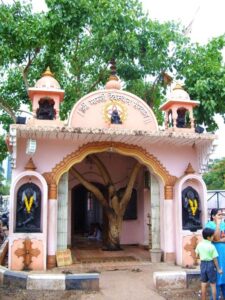
Goans have nurtured a varied cultural heritage that was deeply rooted with the love for ecology and environment. Rivers, springs, trees, wells, patches of forests and animals were considered as the sacred entity and respecting them whole heartedly was one of the unavoidable principles of their primitive religion.
Tree worship in Goa: Pipal worship

In Goa, the Pipal (Ficus religiosa) tree occupies a place of great respect, and in some places it is worshipped as a deity known as Pipaleshawar. The folk deity Rashtroli is worshipped in the form of a Pipal tree in Asnora, Karaswada and Nanora of Bardez. The holy unseen spirit known as Khazaneshwar of Shivoli is associated with the Pipal tree. Once there were areas with Pipal trees locally known as Pipalamol, Pipalkatta and Pipalaped.
There are folk songs which make reference to the Pipal tree. The famous Datta Mandir of Sankhali has very old giant Pipal trees which add to the divinity and serenity of this temple complex. In many villages of Goa, the Pipal tree usually has a platform around it where people used to sit. Once, in Goa, it was believed that if a boy died before his thread ceremony, he was said to haunt the Pipal tree. There are traditional beliefs among Goan communities, which regard the Pipal as the holy tree and never dare to cut it and enjoy total protection. It has acquired the status of sacredness since time immemorial on account of its utility, and the various stories and myths woven around it.
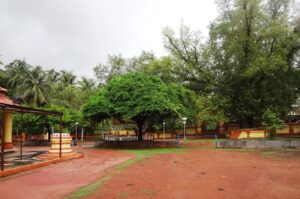
Worship of Tulsi or Vrinda
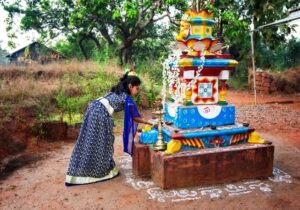
Among the Hindus in Goa, while performing the last rites, leaves of tulsi are put in the mouth of the dead, on the forehead and also in the ears. In order to express their gratitude, devotees prefer to offer garlands of tulsi leaves to Vishnu, Krishna and Pandurang. In rural Goa, Hindu women always pray to the tulsi first and only then go out of the house. In the past, tulsi plants were made of locally available clay and, during religious ceremonies, it was plastered with the green colour of cow dung. They never used to plaster the tulsi plant with the cement and tiles but changing economic circumstances made an impact on Hindu lifestyles, where home owners could afford to plaster, paint and embellish it. In affluent homes, a tulsi plant is placed with glazed tiles that become the centre of focus, as the sunlight beamed from the mangalore-tiled roof over the courtyard. One feature common to all temples in Goa, regardless of their deity, is a tulsi plant. In Goa, tulsi plants are usually set at one side of the front entrance to the Mandap. The tulsi plants themselves vary from the majestic example to the elaborately tile-decorated pedestal. The temple of Malakajan from the Gaodongori of Canacona is the only example of a temple in Goa which has two tulsi vanas.
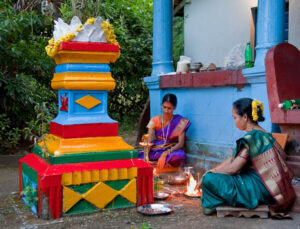
Before the arrival of the Portuguese to Goa, the tulsi plant was kept in a simple clay or terracotta container. After the Portuguese arrived and conversion to Christianity began in earnest, the vrindavan assumed the symbol of Goan Hindu identity and ethnic pride. In Goa, besides having the tulsi plant in front of house, there is also the tradition of building vrindavans by the family in the honour of a married woman who died before her husband’s death. It serves as a memorial and is worshiped on various occasions.

The tulsi plant symbolises the bride, who is wedded to Lord Vishnu, represented in the form of a well-carved green stick of Gino shrub. Sugarcane, gooseberry and tamarind are used on this occasion. In some places, a plant of taikilo (Cassia tora) and in other places a plant of tadmad (Sesbania bipinosa) along with its pods is decorated with the flowers of marigold and is planted in the vrindavan.
Goan Hindus prefer to organize marriage ceremonies only after the festival of tulsi vivah. Even on the occasions of Dhalo, Dhillo, and Katyo, the eco-feministic festivals of Goa, the tulsi plant has an immense place of gratitude. It is an integral part of the Goan Hindus religious and cultural life.
Rice
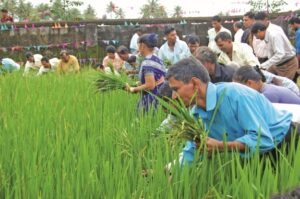
In Hindu mythology, Lord Vishwakarma was related to sowing whereas Brahmadev to planting paddy crops.
Like the rest of India, Goa since time immemorial was known for its rice growing fields. In Goa, the majority of people love to eat fish, curry and rice (Oryza sativa) and they see rice as the very heart of their culture. In some villages of Goa, during festive occasions, people greet guests with specially prepared rice dishes like Shirvalyo, Mutali, Sanna and Polle. The khazans or saline flood plains were reclaimed with an intricate system of dykes and sluice gates, urth salt-tolerant rice varieties of Asgo, Dodig, Kochri, Babri, Corgut, Jiresal, Damgo, Sotti and others.
The cultivation of rice was most important for the survival of various communities and that is why different activities connected with cultivation of rice were treated with utmost gratitude.

In most of pre-Portuguese Goa, Ganesh temples were found mainly in the rich rice growing villages of Kudne, Chorao, Carambolim, Ela, Pomburpa and Divar, which were known as the rice bowl. A procession lead by the parish priest and then by the gaunkars, accompanied by a local band, go to the paddy fields and sprinkle the holy water on the crop. The blessed paddy is carried from the altar and securely placed by the Catholics in their kitchens. Many of the agriculture-dominated Catholic villages of Goa celebrate Konsanchem or the harvest festival like the Hindus.
Villages like Sal, Saligao were known for their rice, as their names have evolved from rice varieties. The family deity of the Halid community of Keri-Sattari is Belevansh and this deity is believed to be associated with the Belo variety of rice. The ashatas are rice mixed with kumkum powder, which is considered to be the symbol of prosperity. A heap of rice and betel nut symbolizes Lord Ganesh.
During some festivals, cooked rice mixed with the blood of cock, called choru is sprinkled in different directions to get rid off ghosts. Offerings to the ancestors on festive occasions are made of the special sweet prepared by using rice, jaggery and daal called payas. On Nag Panchami day, some Brahmin communities don’t worship the clay idols of Nag but make an idol out off soaked rice. Every alternate year, the Gaonkars of Morle make a small idol of soaked rice clay and offer it to the holy spirit of the sacred grove of Ghotgachi Rai.
Presently, the khazan lands have been transformed to concrete structures. No serious efforts have been made to collect samples of traditional rice varieties or to conserve the germplasm of the old varieties which are fast disappearing. Educated youth hardly take much interest in agriculture and that is why land plots are sold in return for money, threatening the very future of Goa. The valuable, old rice varieties are replaced by the new hybrid and high yielding rice varieties like Sahyadri, Triguna, Jaya, Jyoti and several others. The use of chemical fertilizers, pesticides and insecticides has reduced their natural taste and their ability to provide natural care. The old rice varieties protecting people from various diseases and pains have already become extinct.
Source
http://mapio.net/pic/p-120681783/
http://blog.parrikar.com/2012/11/25/the-wedding-of-tulsi/
http://theideaofindia.in/wp-content/uploads/2014/08/016.jpg
https://www.pinterest.com/pin/484770347362674569/
http://www.thegoan.net/story_preview.php?id=8373
http://www.goaartlitfest.com/visitors_guide.php


